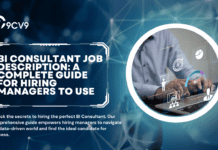Key Takeaways
- Learn how to navigate the CTO career path, from entry-level roles to executive leadership in tech-driven organizations.
- Discover the essential skills, qualifications, and certifications needed to succeed as a Chief Technology Officer in 2025.
- Understand current CTO salary trends, job market demand, and the evolving responsibilities shaping the future of tech leadership.
In today’s fast-paced and innovation-driven world, technology leadership plays a critical role in determining the success and scalability of modern businesses. At the forefront of this transformation stands the Chief Technology Officer (CTO)—a visionary executive responsible for shaping and driving an organization’s technological strategy. As companies across all industries race to integrate emerging technologies, adopt agile practices, and remain competitive in the digital economy, the role of the CTO has become more vital and multifaceted than ever before.

The Chief Technology Officer is no longer just a high-ranking IT manager or system architect. Instead, today’s CTO must be a dynamic leader who blends deep technical expertise with strategic business insight. This executive must not only oversee the development and implementation of innovative technologies but also align those initiatives with the broader organizational goals to drive growth, efficiency, and competitive advantage. As a result, the path to becoming a CTO is both challenging and highly rewarding, requiring a diverse skill set, years of experience, and a proactive approach to continuous learning and leadership development.
This comprehensive analysis explores the CTO career path in meticulous detail, providing a complete roadmap for aspiring technology leaders, mid-level professionals seeking executive roles, and organizations aiming to understand the strategic impact of their tech leadership. From foundational education and essential technical skills to key leadership competencies and industry trends, this guide covers every critical component that shapes the journey to the CTO role.
The blog also delves into the evolving scope of the CTO position in various industries—including finance, healthcare, e-commerce, manufacturing, and software development—and how technological disruptions such as artificial intelligence, cloud computing, cybersecurity, and big data are redefining the expectations placed on today’s CTOs. Furthermore, readers will gain insights into typical career progression stages, from software engineer or systems analyst to senior technical manager, and eventually, into C-suite leadership.
Additionally, this article examines global salary benchmarks, the impact of company size and sector on CTO compensation, and emerging regional differences in CTO hiring trends. It also outlines the importance of certifications, professional networks, and mentorship in accelerating career growth. Real-world examples, data-driven insights, and expert commentary make this guide an indispensable resource for those aspiring to reach one of the most influential positions in the tech industry.
Whether you are a developer just beginning your career, a seasoned IT manager eyeing a leadership promotion, or a business leader looking to hire a visionary CTO, this in-depth exploration will equip you with the knowledge and clarity needed to navigate the complexities of the Chief Technology Officer career path in today’s dynamic digital landscape.
Before we venture further into this article, we would like to share who we are and what we do.
About 9cv9
9cv9 is a business tech startup based in Singapore and Asia, with a strong presence all over the world.
With over nine years of startup and business experience, and being highly involved in connecting with thousands of companies and startups, the 9cv9 team has listed some important learning points in this overview of the Chief Technology Officer (CTO) Career Path.
If your company needs recruitment and headhunting services to hire top-quality employees, you can use 9cv9 headhunting and recruitment services to hire top talents and candidates. Find out more here, or send over an email to [email protected].
Or just post 1 free job posting here at 9cv9 Hiring Portal in under 10 minutes.
Chief Technology Officer (CTO) Career Path: A Comprehensive Analysis
- A Comprehensive and Strategic Analysis
- Unpacking the Scope of the Chief Technology Officer (CTO) Role in 2025
- Navigating the CTO Interview Process in 2025
- Mapping the Career Trajectory of a Chief Technology Officer (CTO) in 2025
- CTO Compensation, Global Demand, and Job Satisfaction in 2025: A Strategic Overview
- The Chief Technology Officer (CTO) Career Landscape in 2025: Strategic Insights and Pathway Recommendations
1. A Comprehensive and Strategic Analysis
Overview: The Strategic Role of the CTO in 2025
The role of the Chief Technology Officer (CTO) in 2025 has evolved into a mission-critical leadership function that transcends traditional IT oversight. No longer confined to infrastructure or technical maintenance, the CTO is now a central architect of business innovation, digital transformation, and long-term value creation.
CTO Responsibilities in 2025: A Strategic and Multifunctional Role
- Acts as the chief visionary for technological innovation and enterprise-wide IT alignment
- Integrates advanced technologies—AI, ML, IoT, blockchain—into business models to enhance operational efficiency
- Oversees end-to-end product engineering, cloud infrastructure, and R&D initiatives
- Leads cybersecurity strategies to safeguard digital assets in a volatile threat landscape
- Collaborates with C-suite executives to ensure technology investments align with organizational KPIs and ROI expectations
- Drives sustainability, scalability, and competitive edge through digital transformation
Evolution of the CTO Function: From Technical Manager to Business Strategist
The contemporary CTO role reflects a significant evolution in scope and influence, transitioning from hands-on technical execution to business-aligned innovation leadership.
Historical vs. Current Role Comparison
| Aspect | Traditional CTO Role (Pre-2015) | Modern CTO Role (2025) |
|---|---|---|
| Core Focus | IT systems management, software engineering | Enterprise strategy, digital innovation |
| Executive Influence | Limited to IT budget | Core contributor to corporate growth decisions |
| Tools and Technologies | Servers, databases, legacy systems | AI, cloud, blockchain, quantum computing |
| Talent Management | Technical teams | Cross-functional leadership, culture building |
| External Visibility | Minimal | Public spokesperson for technological direction |
Market Outlook: Rising Demand for Strategic CTOs
Global Hiring Trends
- High-growth demand in sectors such as:
- Financial Services
- E-Commerce
- SaaS and Cloud Computing
- HealthTech and MedTech
- Cybersecurity
- Startup and Scale-up Demand:
- Venture-backed companies are increasingly appointing CTOs early to lead product innovation and tech architecture.
- Enterprise Digital Transformation:
- Enterprises are prioritizing CTO hires to navigate digital maturity, cloud migration, and regulatory compliance.
Projected CTO Job Growth by Region (2025–2030)
| Region | Expected CAGR (%) | Key Growth Drivers |
|---|---|---|
| North America | 8.2% | AI adoption, cybersecurity mandates |
| Western Europe | 7.5% | GDPR, green IT, cloud-based enterprise systems |
| Southeast Asia | 10.4% | Startup boom, digital government initiatives |
| Middle East | 9.1% | Smart city projects, sovereign cloud adoption |
Typical CTO Career Path: Roadmap to the C-Suite
A career in technology leadership is rarely linear. However, successful CTOs often exhibit a progressive climb marked by technical mastery, people management, strategic vision, and innovation foresight.
CTO Career Progression Matrix
| Career Stage | Title | Core Responsibilities | Typical Years of Experience |
|---|---|---|---|
| Entry-Level | Software Developer / Engineer | Code development, system troubleshooting | 0–3 years |
| Mid-Level | Technical Lead / Engineering Manager | Project leadership, mentorship, solution architecture | 4–8 years |
| Senior-Level | VP of Engineering / IT Director | Strategic planning, team management, budget oversight | 9–15 years |
| Executive-Level | CTO | Enterprise tech strategy, innovation leadership, external liaison | 15+ years |
Education, Certifications, and Technical Expertise
Common Academic Backgrounds
- Bachelor’s Degree in Computer Science, Information Technology, or Engineering (mandatory)
- Master’s Degree in Technology Management, Business Administration (often preferred)
- Specialized programs in Digital Transformation or Leadership for Technologists (increasingly in demand)
In-Demand Certifications for CTOs in 2025
| Certification | Issuing Body | Value Proposition |
|---|---|---|
| Certified Chief Technology Officer (CCTO) | EC-Council | Executive-level strategic leadership in tech management |
| Certified Information Systems Security Pro | (ISC)² | Cybersecurity risk leadership at the C-suite level |
| AWS Certified Solutions Architect | Amazon Web Services | Enterprise cloud architecture for scalable operations |
| TOGAF Certification | The Open Group | Enterprise architecture for large-scale digital frameworks |
Key Competencies and Skills Required in 2025
Technical Expertise
- Cloud-native infrastructure (AWS, Azure, GCP)
- Cybersecurity architecture
- DevOps and CI/CD frameworks
- Enterprise software integration
- Advanced data analytics, AI, and ML models
Strategic & Leadership Skills
- Business acumen and financial literacy
- Stakeholder communication and board reporting
- Change management and digital transformation
- Talent acquisition and organizational development
- Ethical technology governance and compliance
CTO Salary Benchmarks and Job Satisfaction
Global CTO Compensation in 2025
| Country | Average Annual Base Salary (USD) | Stock/Equity Options | Bonuses/Incentives |
|---|---|---|---|
| United States | $250,000 – $400,000 | Yes (especially in tech firms) | 15–25% annual performance |
| United Kingdom | $200,000 – $320,000 | Often available | 10–20% |
| Singapore | $180,000 – $270,000 | Increasingly common in startups | 10–25% |
| Germany | $170,000 – $260,000 | Yes (especially in SaaS firms) | 8–20% |
| UAE | $160,000 – $240,000 (tax-free) | Equity rarely offered | 5–15% |
Job Satisfaction Levels
- High Satisfaction: Autonomy, influence, creative freedom, strategic input
- Common Stressors: Cyber threats, high responsibility, constant change
- Retention Insight: Companies offering continuous learning and innovation autonomy retain CTOs longer
Conclusion: Why Understanding the CTO Path Matters in 2025
In 2025, the Chief Technology Officer plays a mission-critical role in defining a company’s technological destiny. From innovation management to strategic planning and cybersecurity defense, the CTO drives both resilience and relevance in the digital-first economy.
This comprehensive guide will serve as an authoritative reference for:
- Aspiring professionals seeking clarity on the CTO journey
- Hiring managers and executive recruiters assessing top tech talent
- Businesses aiming to align technology with core strategic goals
- Educators and institutions designing future-ready tech leadership programs
2. Unpacking the Scope of the Chief Technology Officer (CTO) Role in 2025
Overview: Strategic, Technical, and Innovation-Focused Leadership
The Chief Technology Officer (CTO) in 2025 occupies a pivotal executive role that sits at the confluence of technological advancement, organizational strategy, and enterprise innovation. Unlike historical interpretations of the role, modern CTOs are not confined to backend infrastructure management. They are visionary strategists, people leaders, and innovation catalysts responsible for aligning technology investments with long-term business goals.
Key Strategic Responsibilities of a Modern CTO
- Technology Vision and Roadmap Development
- Formulates and executes a long-term technology roadmap aligned with organizational mission and growth strategy
- Evaluates emerging technologies for relevance, feasibility, and strategic advantage
- Integrates digital transformation objectives into enterprise-level planning
- Cross-Functional Alignment
- Collaborates with the CEO, CIO, CMO, and CFO to ensure technological initiatives support revenue, customer experience, and cost-efficiency goals
- Translates technical insights into actionable business strategies
- Enterprise Architecture Governance
- Leads the design of scalable, secure, and resilient enterprise architectures
- Oversees the modernization of legacy systems to maintain competitive agility
Core Managerial Functions and Team Leadership
- Technical Team Oversight
- Directs engineering, DevOps, cybersecurity, data science, and infrastructure teams
- Defines and monitors KPIs across all technical departments
- Establishes a high-performance culture driven by innovation, ownership, and accountability
- Talent Acquisition and Development
- Recruits, trains, mentors, and retains top-tier technical talent
- Promotes continuous learning and upskilling in line with evolving technology trends
- Budget and Resource Management
- Manages multi-million-dollar technology budgets
- Ensures optimal allocation of capital and human resources across product development and infrastructure projects
- Leads financial forecasting, cost analysis, and vendor negotiations
| Managerial Area | Typical Activities |
|---|---|
| People Management | Talent acquisition, succession planning, team structuring |
| Vendor/Partner Relations | Negotiation with SaaS vendors, tech alliances, outsourcing contracts |
| Infrastructure Oversight | Cloud platform administration, network security protocols, DevOps pipelines |
| Budget Responsibility | Budget planning, resource allocation, cost control |
Driving Innovation and Competitive Differentiation
- Emerging Technology Evaluation
- Continuously monitors developments in AI, quantum computing, edge computing, blockchain, and Web3
- Leads proof-of-concept (PoC) trials and risk assessments for adopting new tech stacks
- Internal Innovation Programs
- Builds innovation labs or R&D hubs to accelerate product experimentation and prototyping
- Implements agile methodologies to drive iterative improvements in tech delivery
- External Partnerships
- Establishes strategic alliances with technology providers, universities, accelerators, and open-source communities
- Facilitates knowledge exchange and co-development of emerging technologies
| Innovation Lever | Role of the CTO |
|---|---|
| Research & Development (R&D) | Fund and lead experimental technology initiatives |
| Product Innovation | Introduce new features and services aligned with market needs |
| Intellectual Property Strategy | Secure patents, trademarks, and proprietary algorithms |
Cybersecurity, Compliance, and Risk Mitigation
- Cybersecurity Strategy
- Designs and enforces cybersecurity architecture and protocols to guard against escalating threats
- Implements zero-trust security models and incident response frameworks
- Compliance Leadership
- Ensures compliance with global standards including GDPR, HIPAA, ISO/IEC 27001, and industry-specific mandates
- Maintains data governance policies and ethical AI usage standards
- Risk Assessment and Mitigation
- Conducts regular risk audits and penetration tests
- Oversees disaster recovery planning and business continuity measures
| Risk Area | CTO Role in Mitigation |
|---|---|
| Data Breaches | Establish real-time threat monitoring and incident response protocols |
| Regulatory Fines | Ensure technological compliance with evolving regional and global legislation |
| Operational Downtime | Deploy redundant systems and cloud-native architectures for resilience |
Contextual Variation in CTO Roles: Startup vs. Enterprise
The scope and nature of the CTO’s responsibilities differ significantly based on organizational maturity, industry vertical, and growth stage.
Startup CTO (Pre-Seed to Series B)
- Leads product architecture, MVP development, and codebase implementation
- Engages in investor presentations and tech due diligence for fundraising
- Often assumes responsibilities across operations, product, and sometimes even marketing
Enterprise CTO (Mature Corporations)
- Shapes long-term IT and innovation strategies aligned with global operations
- Oversees large-scale teams and cross-border infrastructure
- Interfaces regularly with regulatory bodies, enterprise partners, and investor boards
| Company Type | CTO Focus | Tech Stack Involvement |
|---|---|---|
| Early-Stage Startup | Product building, rapid prototyping, full-stack coding | Hands-on and highly involved |
| Mid-Stage Scale-up | Infrastructure optimization, team scaling | Mid-level architectural input |
| Enterprise | Strategic alignment, risk mitigation, global scaling | Delegates to specialized teams |
Summary: The Expanding Influence of the CTO in 2025
By 2025, the Chief Technology Officer is a cornerstone of enterprise growth, innovation, and technological resilience. Their role is no longer just about managing servers or software—it is about:
- Orchestrating enterprise-wide digital transformation
- Driving long-term innovation strategies
- Building resilient, scalable, and secure digital ecosystems
- Aligning every technological decision with broader business objectives
The CTO is not only a technologist but also a strategic enabler of business value—combining leadership, innovation, and execution into one powerful function at the heart of the modern enterprise.
3. Navigating the CTO Interview Process in 2025
Overview: Executive Screening for Strategic Technology Leadership
In 2025, the interview process for the Chief Technology Officer (CTO) position has become increasingly multifaceted, reflecting the expanding complexity and strategic importance of this executive role. Organizations now approach CTO recruitment as a rigorous, multi-stage assessment that extends beyond technical acumen to encompass enterprise vision, leadership capacity, and cultural alignment.
This process is not merely designed to evaluate technological proficiency but is strategically structured to assess a candidate’s ability to:
- Architect and execute business-aligned technology strategies
- Lead cross-functional, high-performing engineering and innovation teams
- Navigate the risks, complexities, and pace of modern digital ecosystems
- Drive sustainable transformation through technology adoption and process reengineering
Core Evaluation Pillars in a CTO Interview Process
The CTO interview process typically spans four major assessment categories, each of which is tailored to evaluate a different executive competency:
1. Technical Competence and Engineering Judgment
- Assesses command of modern software architecture, infrastructure, DevOps, data governance, and cybersecurity principles
- Evaluates the candidate’s track record in:
- Architecting scalable enterprise platforms
- Selecting optimal tech stacks for different business scenarios
- Executing system migrations and modernizations
- Enforcing data privacy and cloud security policies
- Key Focus Areas:
- Build vs Buy Decisions
- Refactor vs Rebuild Tradeoffs
- System Scalability and Performance Optimization
- Vendor and Toolchain Evaluation
2. Strategic and Visionary Thinking
- Examines the candidate’s ability to:
- Align technology with short- and long-term business objectives
- Drive innovation pipelines and digital transformation agendas
- Anticipate technological shifts and prepare future-proof architectures
- Strategic areas of questioning include:
- Technology roadmapping and forecasting
- AI/ML, blockchain, and cloud-native integration strategies
- Competitive positioning via technology innovation
- Prioritizing tech investments against business KPIs
3. Leadership, Team Building, and People Strategy
- Focuses on leadership style, people management, and organizational development
- Evaluates the candidate’s effectiveness in:
- Structuring and scaling technical teams
- Nurturing a culture of continuous learning and engineering excellence
- Driving employee retention and mentorship programs
- Leading during high-stress product launches, outages, or turnarounds
- Leadership Dimensions:
- Diversity and inclusion in hiring practices
- Talent upskilling and capability building
- Decision-making transparency and team autonomy
- Agile transformation leadership
4. Behavioral and Cultural Fit
- Investigates behavioral patterns, emotional intelligence, and executive presence
- Common scenarios explored:
- Managing internal conflicts or cross-functional disagreements
- Responding to failure or underperformance in high-visibility initiatives
- Influencing non-technical stakeholders such as board members or investors
- Navigating ambiguous or fast-changing business contexts
- Cultural Compatibility Indicators:
- Communication style under stress
- Decision-making under uncertainty
- Alignment with corporate mission and innovation culture
- Ethical technology leadership in data-sensitive environments
Sample CTO Interview Question Matrix (2025 Format)
| Category | Sample Questions | Purpose of Assessment |
|---|---|---|
| Technical | – How do you select a tech stack for a multi-tenant SaaS platform? – Describe a complex system you architected. – How do you ensure data integrity and scalability in cloud environments? | Evaluate depth of technical insight and architectural decision-making. |
| Strategic | – How do you align your tech roadmap with a 3-year business strategy? – What KPIs do you use to measure tech ROI? – How do you evaluate emerging technologies for business integration? | Gauge strategic foresight and business alignment capabilities. |
| Leadership | – How do you build an engineering culture across global teams? – Describe your team performance improvement strategy. – How do you handle tech team attrition? | Assess team leadership, retention, and talent development approach. |
| Behavioral | – Tell me about a time you managed a high-risk outage. – How do you handle stakeholder misalignment? – Share a project where you pivoted due to market or tech shifts. | Understand crisis management, communication, and adaptability. |
Multi-Round CTO Interview Architecture (Illustrative)
| Stage | Stakeholders Involved | Primary Focus Area | Format |
|---|---|---|---|
| Initial Screening | Executive Recruiter / CHRO | Cultural alignment, career trajectory | Video/Phone Interview |
| Technical Deep-Dive | VP of Engineering / Architect Panel | Systems thinking, architectural knowledge | Whiteboard + Scenario-Based |
| Strategic Visioning Round | CEO, COO | Business alignment, technology transformation | Presentation + Q&A |
| Leadership Assessment | CHRO / Peer CTOs | People management, team design, motivation | Behavioral Interview |
| Final Board/Investor Panel | Board of Directors / PE/VC Partners | Growth enablement, innovation, ROI delivery | Executive Strategy Dialogue |
Key Takeaways for Organizations and Candidates
For Organizations Hiring a CTO in 2025
- Build a structured, cross-functional interview framework
- Balance technical depth with strategic foresight
- Include cultural assessments and real-world simulation cases
- Consider internal stakeholder alignment early in the process
For CTO Candidates
- Prepare to articulate both technical breadth and executive presence
- Align answers with business outcomes, not just technology wins
- Demonstrate team-building philosophy, not just project delivery
- Present a vision for innovation and scalable tech architecture
4. Mapping the Career Trajectory of a Chief Technology Officer (CTO) in 2025
Introduction: The Strategic Nature of the CTO Career Path
In 2025, the career path to becoming a Chief Technology Officer (CTO) is marked by a deliberate and disciplined ascent through both technical and leadership domains. No longer limited to technology oversight, modern CTOs serve as core architects of enterprise innovation, transformation, and growth strategy. Achieving this prestigious executive position necessitates a robust combination of technical mastery, cross-functional leadership, and business intelligence—developed progressively through education, work experience, strategic roles, and ongoing professional development.
Academic Foundations and Executive Readiness
Educational Prerequisites and Preferred Degrees
A foundational education in technology or engineering is essential to launch a successful CTO career. As organizational demands increase, advanced degrees have become increasingly favored—particularly those that integrate business and technology.
- Common Undergraduate Degrees
- Bachelor of Science in:
- Computer Science
- Software Engineering
- Electrical or Electronics Engineering
- Information Systems
- Data Science or Mathematics
- Bachelor of Science in:
- Advanced and Specialized Graduate Programs
- Master of Business Administration (MBA) with a focus on IT or Innovation Strategy
- Master of Science (M.S.) in:
- Technology Management
- Computer Engineering
- Cybersecurity
- Data Analytics
- Emerging Preferences in 2025
- Hybrid programs blending business and technology (e.g., Executive MBA in Digital Leadership)
- Professional certificates in cloud architecture, AI ethics, or enterprise systems
Typical Career Progression to CTO
The journey to the CTO office is neither linear nor identical across organizations, yet certain milestones and career stages are consistent among top-tier technology executives.
CTO Career Path Progression Matrix
| Career Stage | Representative Roles | Core Competencies Developed | Typical Experience Range |
|---|---|---|---|
| Entry-Level | Software Developer, System Admin, Junior Web Engineer | Technical proficiency, problem-solving, codebase management | 0–3 years |
| Mid-Level | Senior Engineer, Architect, Project Manager | System architecture, collaboration, agile development, project delivery | 3–7 years |
| Technical Management | Engineering Manager, Team Lead, Head of Development | Team leadership, mentoring, sprint planning, stakeholder communication | 7–10 years |
| Senior Leadership | Director of Engineering, VP of Technology, Head of Product Tech | Strategic planning, cross-department alignment, budgeting, scalability | 10–15 years |
| Executive Leadership | Chief Technology Officer (CTO) | Business alignment, enterprise leadership, innovation strategy | 12–20+ years |
Key Milestones on the CTO Journey
1. Technical Foundation and Engineering Mastery
- Mastery of programming languages, system architecture, and data models
- Hands-on experience with distributed systems, DevOps, cloud-native development
- Understanding of cybersecurity frameworks and scalable infrastructure solutions
2. Mid-Level Leadership and Functional Oversight
- Management of product development cycles and agile teams
- Coordination of software testing, deployment, and quality assurance
- Increasing exposure to product-market fit and business constraints
3. Transitioning into Executive Roles
- Budget forecasting and operational planning for technology divisions
- Liaising with C-suite peers on aligning technical KPIs with business OKRs
- Leading organizational transformation through digital initiatives
Essential Skill Sets for CTO Readiness in 2025
The CTO role demands a rare convergence of deep technological insight, executive leadership, and strategic foresight. Candidates must actively develop this trifecta over time.
1. Technical Expertise
- Enterprise Architecture
- Cloud Infrastructure (AWS, Azure, GCP)
- Data Governance and Cybersecurity
- Emerging Technologies (AI, Blockchain, IoT)
2. Leadership Competence
- Building and mentoring diverse tech teams
- Driving cultural transformation in engineering departments
- Managing cross-functional teams across geographies
3. Business and Strategic Acumen
- Financial literacy and ROI-driven decision making
- Vendor and stakeholder management
- Vision creation and long-term roadmapping
Professional Development and Lifelong Learning
In a landscape defined by exponential technological shifts, continuous upskilling is essential for maintaining relevance and credibility in CTO roles.
High-Impact Certifications for CTOs in 2025
| Certification | Issuer / Institution | Relevance |
|---|---|---|
| Certified Information Systems Security Professional (CISSP) | ISC² | Cybersecurity leadership and data protection expertise |
| Microsoft Certified: Azure Solutions Architect Expert | Microsoft | Cloud architecture and infrastructure design |
| AWS Certified Solutions Architect – Professional | Amazon Web Services | Scalable and fault-tolerant enterprise solutions |
| TOGAF 10 Certification | The Open Group | Enterprise IT architecture for large-scale organizations |
| Certified Chief Technology Officer (CCTO) | EC-Council | Strategic leadership and executive readiness |
Timeframe to Reach CTO Role
Average Experience Required (2025 Estimates)
| Organization Size | Years of Cumulative Experience | Years in Leadership Roles | Key Considerations |
|---|---|---|---|
| Tech Startups (Seed to Series B) | 8–10 years | 4–6 years | Hands-on CTOs expected; emphasis on execution speed |
| Mid-Sized Enterprises | 10–15 years | 7–10 years | Broader oversight, larger team leadership expectations |
| Fortune 500 / Global Firms | 15–20+ years | 10–12+ years | Must demonstrate enterprise transformation capabilities |
Final Perspective: CTO as the Apex of a Multi-Dimensional Career
In conclusion, ascending to the role of Chief Technology Officer in 2025 is the culmination of decades of progressive experience, cross-disciplinary skill-building, and strategic innovation leadership. It is a career shaped not only by technical excellence but also by the ability to manage transformation, empower teams, and architect the future of an organization’s technological ecosystem.
For professionals aspiring to the CTO chair, the path is long but navigable—with the right mix of experience, adaptability, and vision.
5. CTO Compensation, Global Demand, and Job Satisfaction in 2025: A Strategic Overview
In the contemporary digital economy, the Chief Technology Officer (CTO) has emerged as one of the most strategically vital roles in the C-suite. As organizations across sectors prioritize digital transformation, cybersecurity resilience, and innovation, the market value of seasoned CTOs has surged. In 2025, the compensation structure of CTOs reflects not only their technical expertise but also their impact on long-term business strategy, scalability, and competitive advantage.
CTO Salary Benchmarks: Regional, Sectoral, and Experience-Based Breakdown
National Compensation Trends (United States)
- The average CTO base salary in the U.S. spans a wide range depending on geography, industry vertical, and organizational scale:
- Low end: ~$166,511
- High end: ~$264,557
- Top-tier total compensation: Exceeds $278,000 on average
- Entry-level CTOs (typically in smaller firms or recently promoted executives) earn approximately $104,278 annually
- CTOs with 7+ years of senior experience can command over $226,500
Geographic Differentiation (U.S. Market)
| City/Region | Average Annual CTO Salary | Data Source |
|---|---|---|
| San Francisco | ~$330,405 | Salary.com |
| New York City | $232,677 – $251,051 | Built In, Salary.com |
| Los Angeles | ~$247,934 | Built In |
| Colorado | ~$175,089 | SalaryExpert |
| Remote U.S. Roles | ~$210,000 – $260,000 | Averaged Estimates |
International Salary Comparisons
| Location | Average Salary (Annual) | Conversion Notes |
|---|---|---|
| Canada | $200,000 – $350,000 (CAD) | Approx. $150K–$260K USD |
| United Kingdom | £180,000 – £280,000 | Approx. $225K–$350K USD |
| Ho Chi Minh City (Vietnam) | ₫1.003B – ₫1.271B VND / ~$94,219 USD (remote roles) | Emerging tech hub with startup opportunities |
| Germany | €160,000 – €260,000 | High in fintech and AI-intensive industries |
| Singapore | SGD $250,000 – $380,000 | Strong demand in fintech, logistics, and SaaS |
CTO Compensation Package: Beyond Base Salary
1. Additional Cash Bonuses
- Annual bonuses range between $39,792 to $55,026
- Performance incentives often tied to:
- Digital transformation KPIs
- Product delivery timelines
- Security and infrastructure stability metrics
2. Equity and Stock Options
- Especially prevalent in startup and scale-up environments:
- Early-stage startups: 0.5% – 3% equity
- Late-stage or Series C+ firms: 0.1% – 1% equity with vesting schedules
- CTO equity is often structured with 4-year vesting and 1-year cliff
3. Benefits and Perks
- Standard corporate benefits:
- Health, dental, and vision insurance
- Paid time off, parental leave, and retirement contributions
- Supplementary executive perks:
- Professional development budgets (e.g., certifications, conferences)
- Gym memberships, mental health support, remote work stipends
- Executive coaching or board mentorship programs
CTO Role Demand: Growth Trends and Market Outlook
Global and U.S. Market Demand for CTOs
The global demand for Chief Technology Officers has surged in tandem with the intensification of digital disruption and AI integration.
- Job posting growth: 27% – 30% increase in postings over the past 3 years
- Long-term job growth projection (U.S.):
- 17% growth (2023–2033) for the broader category of Computer and Information Systems Managers, including CTOs (U.S. Bureau of Labor Statistics)
- Top hiring sectors:
- Financial technology (fintech)
- Artificial Intelligence and Machine Learning startups
- HealthTech and MedTech enterprises
- E-commerce and cloud-native platforms
- Startup funding cycles driving CTO demand:
- Seed and Series A companies often prioritize hiring a hands-on CTO
- Series B+ firms seek CTOs with strategic transformation experience
CTO Job Satisfaction and Career Fulfillment Metrics
Despite the operational intensity and frequent high-stress demands associated with the CTO position, overall job satisfaction remains notably high.
Job Satisfaction Metrics (2025 Insights)
| Satisfaction Factor | Rating / Insight |
|---|---|
| Overall Job Satisfaction | ~4.2 out of 5 (Glassdoor, Payscale, Built In) |
| Professional Fulfillment | High, due to innovation influence and tech autonomy |
| Work-Life Balance | Medium to low, varies by company size and culture |
| Career Progression | Strong upward mobility to CIO, COO, and advisory board roles |
| Burnout Risk | Moderate to high in hypergrowth startups or underfunded tech orgs |
Top Challenges Reported by CTOs
- Balancing innovation with technical debt
- Hiring and retaining top-tier engineers
- Managing cross-department expectations (especially with Sales/Product)
- Keeping up with cybersecurity risks and compliance regulations
- Maintaining stakeholder alignment under shifting business priorities
Comprehensive CTO Compensation Snapshot (2025)
| Factor | Details |
|---|---|
| Base Salary (U.S. Average) | $166,511 – $264,557 |
| Entry-Level Salary | ~$104,278 (Payscale) |
| Senior CTO Salary | ~$226,536 (Built In) |
| Total Compensation (with Bonus) | Up to ~$600,000 in high-performing or public companies |
| Bonus Range | ~$39,792 – $55,026 annually |
| Equity (Startups) | 0.5% – 3%, depending on maturity stage and funding size |
| Job Growth Outlook (US) | 17% projected increase through 2033 (BLS), with 30% job posting growth noted |
| Job Satisfaction Rating | ~4.2/5 average |
Conclusion: The ROI of a CTO in 2025
As digital infrastructure becomes a strategic differentiator across industries, the CTO has transitioned from a behind-the-scenes technologist to a frontline business leader. The compensation structures now reflect this evolution—rewarding CTOs for both technical innovation and executive decision-making. With demand continuing to grow globally, and job satisfaction remaining high despite increasing complexity, the CTO career path in 2025 offers both financial and professional reward for those who master its demands.
6. The Chief Technology Officer (CTO) Career Landscape in 2025: Strategic Insights and Pathway Recommendations
In 2025, the Chief Technology Officer (CTO) stands as a central figure in shaping the technological vision and innovation agenda of forward-thinking enterprises. Far beyond a technical lead, the modern CTO serves as a business strategist, digital innovator, and organizational change agent. As businesses across all industries deepen their reliance on digital infrastructure and emerging technologies, the demand for visionary, business-savvy technology executives continues to accelerate.
Strategic Scope and Executive Impact of the CTO Role
Core Responsibilities of a CTO
The CTO role encompasses a multifaceted blend of strategic, technical, and operational responsibilities:
- Technology Strategy Development
- Design and execute a long-term technological roadmap aligned with business goals
- Assess emerging technologies for competitive advantage
- Innovation Leadership
- Spearhead R&D and digital transformation initiatives
- Introduce scalable and future-ready infrastructure
- Organizational Alignment
- Collaborate with C-suite to embed technology within strategic planning
- Integrate IT priorities with operational performance metrics
- Risk Management and Security
- Oversee enterprise cybersecurity frameworks and compliance
- Implement robust disaster recovery and business continuity plans
Career Trajectory: Experience and Evolution
Pathway to the CTO Office
Most CTOs ascend through a multi-stage career ladder combining technical mastery and progressive leadership responsibility.
| Career Stage | Representative Roles | Key Milestones | Years of Experience |
|---|---|---|---|
| Entry-Level | Software Engineer, System Admin | Technical foundation, coding, systems knowledge | 0–3 years |
| Mid-Level | Senior Developer, Product Manager | Architecture, project delivery, cross-team synergy | 3–7 years |
| Technical Management | Engineering Manager, Head of Development | Team management, budgeting, delivery planning | 7–10 years |
| Executive Leadership | VP of Engineering, Director of Technology | Business alignment, strategic decision-making | 10–15 years |
| Chief Technology Officer (CTO) | CTO, CIO-CTO Hybrid | Full enterprise tech ownership, stakeholder alignment | 12–20+ years |
Interview Landscape: Rigorous Evaluation Criteria
Core Evaluation Domains in CTO Hiring Processes
The CTO interview process in 2025 is highly comprehensive, focusing on four principal dimensions:
- Technical Expertise
- System architecture, cybersecurity, cloud migration, data strategy
- Experience in full-stack environments and emerging technologies
- Strategic Vision
- Long-term technology planning and innovation initiatives
- Aligning tech investments with business KPIs
- Leadership Style
- People management, DEI practices, team-building strategies
- Executive presence and cross-functional influence
- Behavioral Attributes
- Decision-making in ambiguity
- Conflict resolution and adaptability in high-pressure environments
CTO Compensation: Market Trends and Competitive Insights
High-Earning Potential and Incentive Structures
In 2025, CTO compensation is reflective of the executive-level impact required of the role. The total rewards package includes a blend of fixed and performance-based components.
| Compensation Component | Typical Range (U.S.) | Notes |
|---|---|---|
| Base Salary | $166,511 – $264,557 | Varies by region, industry, and company size |
| Bonus | $39,792 – $55,026 | Often tied to KPIs like delivery speed and infrastructure uptime |
| Equity / Stock Options | 0.5% – 3% | Common in startups and scale-ups |
| Total Compensation (Top Firms) | Up to ~$600,000+ | Especially in public companies or global tech firms |
| Executive Perks | Health, travel, training, advisory support | Tailored by employer type and seniority level |
Market Demand and Employment Outlook
Surging Demand for CTOs Across Industries
In response to technological acceleration, enterprise digitalization, and increased cyber threats, the CTO role is witnessing robust hiring momentum.
- Employment Growth Rate (2023–2033):
- 17% projected growth for tech executives and information systems managers (U.S. BLS)
- Recent Trends:
- 27–30% increase in global CTO job postings between 2022 and 2025
- High demand in sectors such as fintech, AI, logistics tech, healthcare IT, and manufacturing automation
Job Satisfaction Metrics and Career Fulfillment
Despite the inherent complexity and responsibility of the role, CTOs report strong satisfaction scores.
Job Satisfaction Dashboard (2025)
| Dimension | Rating / Status |
|---|---|
| Overall Job Satisfaction | ~4.2 out of 5 (Glassdoor, Built In) |
| Work-Life Balance | Moderate, varies based on company maturity stage |
| Autonomy and Strategic Role | High – valued for influence in enterprise decisions |
| Career Longevity | High – advancement to CIO, Board Advisor, or COO |
| Stress and Complexity | High – due to 24/7 accountability and tech volatility |
Key Recommendations for Aspiring CTOs in 2025
Roadmap for Emerging Technology Leaders
To strategically position themselves for a future CTO role, professionals should actively pursue:
- Technical Breadth and Specialization
- Master core programming, systems engineering, and cloud infrastructure
- Stay current with AI, blockchain, IoT, and cybersecurity trends
- Executive Education and Credentials
- Consider an MBA or a Master’s in Technology Management
- Acquire relevant certifications (e.g., CISSP, AWS Certified Architect)
- Leadership and Communication Skills
- Lead cross-functional teams and practice executive-level communication
- Mentor others and participate in cross-departmental initiatives
- Business Acumen and Financial Literacy
- Develop fluency in P&L management, ROI calculation, and enterprise KPIs
- Understand market dynamics, customer needs, and innovation models
- Strategic Networking
- Join CTO communities, speak at tech forums, and contribute to whitepapers
- Build alliances with venture capitalists, product leaders, and CTO peers
Conclusion: The CTO Role as a Cornerstone of Modern Enterprise Growth
In summary, the Chief Technology Officer career path in 2025 exemplifies the convergence of technological mastery, business acumen, and transformational leadership. As the world becomes more digitally interconnected and innovation-driven, CTOs are no longer confined to internal IT oversight—they are driving company-wide initiatives that determine long-term success.
For professionals aspiring to the role, the path demands patience, purpose, and continuous evolution. But those who reach this apex position are uniquely positioned to influence strategic direction, define digital futures, and leave a lasting legacy across industries.
Conclusion
The role of the Chief Technology Officer (CTO) in 2025 has evolved into one of the most strategically significant positions within the modern enterprise. No longer confined to managing internal IT systems, today’s CTOs operate at the forefront of innovation, digital transformation, and organizational growth. As businesses across industries accelerate their adoption of artificial intelligence, cloud computing, cybersecurity frameworks, and emerging technologies, the CTO has become a critical architect of sustainable competitive advantage.
This comprehensive analysis of the CTO career path reveals a dynamic and multifaceted journey—one that demands continuous learning, cross-functional leadership, and deep technical acumen. From foundational education and early-career technical roles to executive leadership and strategic influence, the trajectory toward the CTO position requires dedication, adaptability, and a holistic understanding of how technology drives business success.
Key Takeaways from the CTO Career Path Analysis
- Strategic Relevance: CTOs play a vital role in aligning technology initiatives with business objectives, ensuring technological decisions support long-term value creation, innovation, and operational efficiency.
- Diverse Responsibilities: The CTO oversees areas such as systems architecture, cloud infrastructure, data governance, cybersecurity, digital product development, and cross-departmental collaboration.
- Career Progression: Most CTOs build their careers across stages that include engineering roles, technical leadership positions, and eventually executive-level responsibilities such as VP of Engineering or Director of Technology.
- Educational Foundations: A strong academic background in computer science, engineering, mathematics, or information systems, often supplemented by an MBA or a specialized master’s degree, lays the groundwork for success.
- Leadership and Communication: The ability to lead large teams, communicate with stakeholders, and influence organizational strategy is essential for CTO effectiveness.
- Compensation and Demand: Salaries for CTOs are among the highest in the technology sector, often bolstered by bonuses, stock options, and equity—especially in high-growth startups and enterprise environments. Global demand for CTOs continues to rise, driven by digital transformation, innovation, and cybersecurity needs.
- Interview Readiness: Securing a CTO role involves a rigorous interview process focused on technical mastery, strategic thinking, behavioral agility, and cultural alignment with the executive leadership team.
Why the CTO Role Matters More Than Ever in 2025
In today’s hyper-competitive, data-driven marketplace, the CTO serves as the visionary navigator who steers organizations through technological complexity. Whether scaling infrastructure, enabling secure digital ecosystems, or embedding AI into core business functions, the CTO ensures that companies remain resilient, agile, and future-ready.
The emergence of remote work, digital-first customer experiences, and global cybersecurity threats has only amplified the CTO’s relevance. As companies redefine success through innovation and operational scalability, CTOs are expected to balance technological foresight with pragmatic execution, all while fostering a culture of experimentation and excellence.
Future Outlook: Where the CTO Career is Headed
The future of the CTO career path is shaped by a convergence of trends:
- Increased Boardroom Influence: More CTOs are taking seats on executive boards, shaping decisions around investment, sustainability, and global expansion.
- Cross-Functional Integration: The boundaries between CTO, CIO, and Chief Product Officer are blurring, requiring multi-disciplinary thinking and adaptive leadership.
- Emergence of CTO Specializations: New variants of the CTO role are emerging—such as Chief AI Officer, Chief Innovation Officer, and Chief Security Technologist—reflecting specialized strategic priorities.
- Continuous Learning and Certification: Staying competitive will require CTOs to invest in ongoing learning, certifications in AI, cloud architecture, cybersecurity, and business leadership.
- Globalization of Talent: With remote-first organizations expanding worldwide, CTOs must manage distributed teams and navigate regulatory and operational challenges across borders.
Final Thoughts: Building a Purpose-Driven Technology Career
For aspiring CTOs, the path forward is as challenging as it is rewarding. It is not merely a matter of mastering code or managing teams—it is about becoming a visionary leader who can guide an organization through the uncertainties of technological change and digital disruption. Success in this role hinges on one’s ability to think strategically, lead courageously, execute consistently, and remain curious in a world of constant innovation.
Whether you are a mid-level engineer planning your ascent or a current executive transitioning toward technology leadership, this blog has provided a detailed and data-driven roadmap to help navigate the complexities and possibilities of the CTO career path.
In 2025 and beyond, CTOs will not just build software or manage infrastructure—they will shape the future of industries, influence global markets, and redefine what technology means for humanity.
If you find this article useful, why not share it with your hiring manager and C-level suite friends and also leave a nice comment below?
We, at the 9cv9 Research Team, strive to bring the latest and most meaningful data, guides, and statistics to your doorstep.
To get access to top-quality guides, click over to 9cv9 Blog.
People Also Ask
What is a Chief Technology Officer (CTO)?
A Chief Technology Officer (CTO) is a C-suite executive responsible for overseeing an organization’s technological strategy and innovation.
What does a CTO do?
A CTO leads technology development, aligns tech initiatives with business goals, and manages engineering teams and IT infrastructure.
How do I become a CTO?
Becoming a CTO requires a strong technical background, leadership experience, business acumen, and typically 10+ years in the tech industry.
What degree is needed to become a CTO?
Most CTOs hold a bachelor’s degree in Computer Science or Engineering, and many also pursue an MBA or a Master’s in Technology Management.
How long does it take to become a CTO?
It typically takes 10 to 20 years of progressive experience in technology roles to reach a CTO position.
What are the key responsibilities of a CTO?
A CTO is responsible for setting tech strategy, leading innovation, managing teams, overseeing infrastructure, and aligning technology with business goals.
What skills are required to be a successful CTO?
Skills include technical expertise, strategic thinking, leadership, cybersecurity, cloud computing, and strong communication abilities.
Is an MBA necessary for a CTO role?
An MBA is not mandatory but is highly valued for its focus on business strategy, finance, and executive leadership skills.
What is the average salary of a CTO in 2025?
In 2025, the average CTO salary in the U.S. ranges from $166,000 to over $264,000, with total compensation potentially exceeding $600,000.
How much equity does a startup CTO typically get?
Startup CTOs typically receive 0.5% to 3% equity depending on the company’s stage, size, and investor structure.
What is the job outlook for CTOs?
The demand for CTOs is growing, with a projected 17% increase in employment for tech leaders from 2023 to 2033.
What industries hire CTOs the most?
Industries include software, fintech, healthcare, e-commerce, manufacturing, and telecommunications.
Is a CTO higher than a CIO?
They are often equals but have different focuses—CTOs drive innovation and product tech, while CIOs manage internal IT operations.
What is the difference between a CTO and a VP of Engineering?
A CTO focuses on long-term technology strategy, while a VP of Engineering manages day-to-day development and team performance.
Can a software engineer become a CTO?
Yes, many CTOs begin their careers as software engineers and progress through technical and leadership roles over time.
What certifications are helpful for aspiring CTOs?
Helpful certifications include CISSP, AWS Certified Solutions Architect, PMP, and Certified ScrumMaster.
What are the challenges CTOs face today?
Common challenges include rapid tech changes, cybersecurity threats, budget constraints, and aligning IT with business strategy.
Do CTOs need to code?
While hands-on coding is less common at the executive level, a strong technical background and coding experience are essential.
What is the role of a CTO in a startup?
In startups, CTOs often build the initial tech stack, lead product development, hire engineers, and manage infrastructure.
Can you become a CTO without a degree?
While rare, it is possible to become a CTO through extensive experience, proven leadership, and demonstrated technical expertise.
How is the CTO role evolving in 2025?
CTOs in 2025 are increasingly focused on AI, cybersecurity, sustainability, and driving digital transformation at scale.
What programming languages should a CTO know?
Languages vary by industry, but common ones include Python, Java, JavaScript, Go, and SQL.
How does a CTO contribute to business growth?
CTOs drive innovation, improve tech efficiency, reduce costs, and create products that align with business expansion goals.
What is a fractional CTO?
A fractional CTO is a part-time executive who provides strategic technology leadership to startups or small businesses.
What’s the future demand for CTOs globally?
Global demand for CTOs is increasing, especially in regions focused on tech innovation, digital economy, and cybersecurity.
What soft skills do CTOs need?
CTOs need leadership, communication, emotional intelligence, adaptability, and decision-making skills.
What’s the typical career path to CTO?
Most follow a path from software engineer to tech lead, then to engineering manager, director, and finally CTO.
What are common CTO interview questions?
Expect questions on system architecture, tech stack decisions, leadership style, innovation strategies, and conflict resolution.
What companies pay CTOs the most?
Large tech firms, fintech companies, and SaaS enterprises in cities like San Francisco and New York typically offer the highest CTO salaries.
Sources
Edstellar
Northwest Executive Education
Zartis
N2Growth
CTO Academy
BlackFog
CTOx
Taeho.io
Monster
University of Miami
The CTO Club
LinkedIn Talent Solutions
Wikipedia
Baremetrics
MIT Professional Education
CIO Influence
JobzMall
Bureau of Labor Statistics
CSS ProSearch
DigitalDefynd
Wellfound
Executive Recruit
ZipRecruiter
Salary.com
ERI Economic Research Institute
Kruze Consulting
SalaryExpert
Plane
Built In
Built In NYC
Hapy Co
Evidenced
Shiny
Workable
Karl Hughes
Final Round AI
Go Fractional
Teal
Himalayas
Codemotion Magazine
PayScale
MagicBell
Information Age
Capital Numbers
Reddit
SCS Georgetown University
edX
Tulane University
TechCXO
Quantic
Inkmi
Resume Worded
Maryville University Online
WGU (Western Governors University)
365 Data Science
4DayWeek.io
Hatica
Vadim Kravcenko































![Writing A Good CV [6 Tips To Improve Your CV] 6 Tips To Improve Your CV](https://blog.9cv9.com/wp-content/uploads/2020/06/2020-06-02-2-100x70.png)


